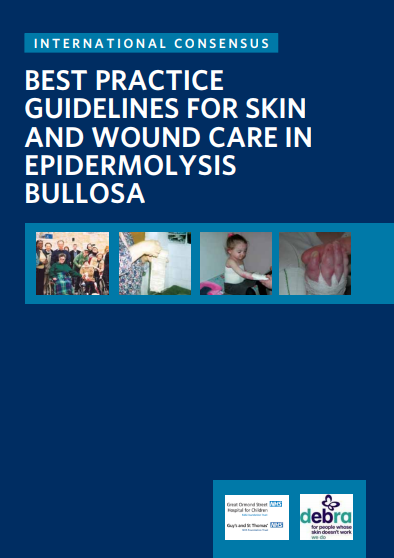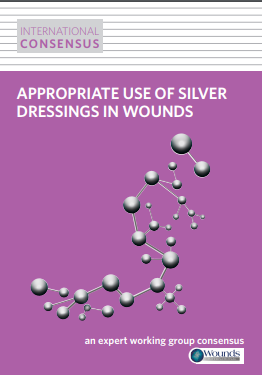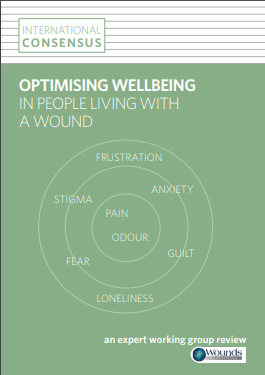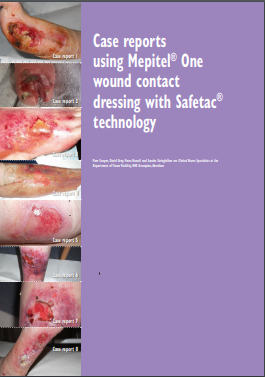Best practice guidelines for skin and wound care in epidermolysis bullosa 2012

These guidelines have been developed to aid clinicians in the management of skin and wound care for patients with the genetic skin fragility disorder epidermolysis bullosa (EB). Management strategies for wounds or wound complications are suggested for patients of any age diagnosed with any form of this genetically inherited disorder. Supported by Urgo Medical
Ensuring that the correct antimicrobial dressing is selected
<p>This article examines the various tools available to clinicians in the fight against the increase of antiobiotic resistance in bacteria and the environmental hazards associated with antibiotics. The importance of employing an effective wound assessment during diagnosis is emphasised, while the selection of antiseptic dressings should always be based on an assessment of the microbial […]
Defining ‘active’ pressure redistribution
<p>This paper will explore the design principles of ‘active’ (alternating) support surfaces, discuss how specific characteristics might influence physiology, pathophysiology and the prevention of pressure ulcers, and introduce the rationale for a standardised performance measurement.</p>
Assessing the use of simulated wounds in nurse education
<p>In the past, nursing students only had access to classroom theory to develop their wound care knowledge. In the project detailed here, simulated wounds were developed to teach nursing students at the University of Salford about tissue viability management, as part of a Vice Chancellor’s funded project. The aim was to design a collection of […]
The challenge of managing burns in a Ghanaian hospital
<p>This article discusses some of the challenges faced by healthcare specialists working in Ghana. The author describes her experience working in a hospital in this West African country as part of an elective placement. She describes some of the cases treated at the unit and discusses the country’s health service from a Western perspective.</p>
Day in the life 3(3)
<p>This issue features Severin Läuchli who is a staff physician and faculty member at the Department of Dermatology, University Hospital Zurich, and president of the Swiss Association for Woundcare (SAfW).</p>
Expert Commentary: The dangers of faecal incontinence in the at-risk patient
<p>In the past decade, incontinence-associated dermatitis (IAD) has become a 'buzzword' of sorts in the wound care arena.</p>
Managing diabetic foot ulceration with a new, highly portable NPWT device
<p>This article examines the use of highly portable negative pressure wound therapy (NPWT) in the management of diabetic foot ulceration, a significant sequelae of diabetes that affects some 61,000 people in the UK at any given time. NPWT is a non-invasive therapy that uses controlled sub-atmospheric pressure in a closed system applied to a wound […]
The dangers of faecal incontinence in the at-risk patient
<p>Faecal incontinence can have serious consequences for a patient's skin, quality of life and dignity. Clinicians and support workers need to be aware of the impact faecal incontinence can have on individual patients. This article identifies the negative effects of faecal incontinence in relation to morbidity, quality of life and health economics.</p>
The importance of international engagement
<p>Suzie Calne discusses the impact and importance of events that bring people together.</p>
Minimising pain and trauma during wound dressing procedures
<p>The incidence of chronic wounds has been increasing globally with the rise in the number of diabetic patients and an ageing population. It is expected that the incidence of neuropathic pain due to chronic wounds will also increase. This case features a patient diagnosed with Buerger’s disease and type 2 diabetes mellitus who presented with […]
Preventing pressure ulcers occurring on the heel
<p>Pressure ulcers are defined as localised injury to the skin and/or underlying tissue, usually over a bony prominence, as a result of pressure, or pressure in conjunction with shear. An important change to this definition is the elimination of friction as a cause of pressure ulcers. Patients can develop friction injury to the heel from […]
Expert consensus on a new enzyme alginogel
<p>Flaminal® (Flen Pharma) products are alginate gels containing a novel antimicrobial enzyme system. They are designed to promote wound healing and to restore bacterial balance and their use on a wide range of wound types is supported by scientific and clinical evidence[1–4].</p>
Day in the life 3(2)
<p>This issue features Margaret Mungai, a wound care nurse at Moi Teaching and Referral Hospital in Kenya.</p>
A synthetic skin scaffold to treat full-thickness wounds
<p>An independent UK-based charity has spent several years developing a synthetic ‘off-the-shelf’ skin scaffold which could prove effective at wound healing. The charity, known as RAFT (the Restoration of Appearance and Function Trust), is unique among many medical charities in the sense that it raises money for its own research institute and team of researchers.</p>
Infection update
<p>Wounds International clinical updates present recent developments in the field of leg ulcers, pressure ulcers, skin integrity and diabetic foot, including the latest from associations, clinicians and industry. If you use an innovative technique in your practice that you would like us to feature in future issues, please email the editor at: [email protected]</p>
Infection update: Expert commentary
<p>Of the thousands of microorganisms in existence, there are only a limited number that colonise the human host. Some can cause disease (pathogens) and the remainder (non-pathogens) cannot because they do not have the mechanisms to do so. This is not always consistent and we now know that a microorganism can lose and acquire pathogenic […]
How to… Top tips for managing venous leg ulcers
<p>A leg ulcer is defined as a loss of skin below the knee, which takes more than six weeks to heal[1] [Fig 1]. Venous leg ulcers are caused by sustained high pressure within the venous system of the leg. Over half are caused by progressive venous reflux that begins as varicose veins, and the remainder […]
The important role of debridement in wound bed preparation
<p>Although the literature highlights the importance of wound debridement, there is often confusion around selecting the most appropriate method[1]. In addition, concerns around competence and scope of practice are an important factor when discussing this technique[2]. The author aims to clarify the fundamentals of successful debridement in the clinical practice setting.</p>
Rediscovering alginate dressings
<p>It is approaching 30 years since the first commercially available alginate wound dressing was launched in 1983. This review revisits this group of wound dressings and traces their development, mode of action and use in clinical practice. The author concludes by posing questions about the future for alginate dressings and identifying unanswered questions related to […]
Preventing post-operative blisters following hip and knee arthroplasty
<p>The aim of this study was to assess the ability of an absorbent foam dressing in preventing post-operative wound blistering following hip and knee arthroplasty. Complications following hip and knee arthroplasty are surprisingly common with widespread reports of wound blistering, leakage and infection. The selection of suitable dressings for the treatment of such wounds is, […]
Indications for the use of MatriDerm® in the treatment of complex wounds
<p>Until recently, the gold standard treatment for covering full-thickness skin defects that required surgery was the use of a full-thickness skin graft in small defects and split-thickness skin grafts in larger instances. The use of full-thickness skin grafts is limited due to the size and availability of suitable donor sites. The use of split-thickness skin […]
Using antimicrobial foam dressings in paediatric wounds
<p>Kendall™ AMD antimicrobial foam dressings are highly absorbent foam dressings that contain polyhexamethylene biguanide (PHMB — also known as polihexanide) an effective antimicrobial agent that has very low cytotoxicity. These dressings are particularly suited to the management of acute or chronic wounds with moderate to high levels of exudate where there is an increased risk […]
The human cost of living with a wound
<p>Time does indeed fly. It seems an age ago that I was in Cape Town attending a roundtable discussion, which was part of a project aimed at providing consensus on patient wellbeing. In fact, the conference only took place in January 2011, but the flood of developments in wound care since then shows how fast-moving […]
International consensus: Appropriate use of silver dressings in wounds

Topical antimicrobial dressings, including those that contain silver, are used to prevent or manage infection in a wide range of wounds. Although silver dressings have been used extensively, a recent study1 and two Cochrane reviews2,3 have concluded that there is insufficient evidence to show that silver dressings improve healing rates. The overall effect has been […]
International consensus: Optimising wellbeing in people living with a wound

Although health care has increasingly become patient-centred, clinicians, healthcare organisations and industry all have important roles in ensuring that care is delivered effectively and takes account of the complex needs of individuals living with a wound. Supported by Smith & Nephew
Learning the easy way…
<p>Suzie Calne discusses the challenge of providing stimulating and relevant wound care education</p>
Both skill and sensitivity are needed for paediatric patients
<p>By working together we can improve the standard of paediatric wound care, say Guido Ciprandi, Marco Romanelli, Corrado Durante, Mona Baharestani and Martin Meuli.</p>
Day in the life 3(1)
<p>This issue features Monica Walusimbi, a registered nurse and midwife at Mulago Hospital in Kampala, Uganda.</p>
The impact of traditional treatments on wound care in sub-Saharan Africa
<p>Francis Ojok, Bua Emmanuel and Regina Akise discuss the findings of their study into the problems clinicians face when dealing with traditional remedies</p>
Skin integrity update
<p>Peter Vowden, Tracy Nowicki, Karen Ousey and Connie Harris report on several Skin Integrity topics. If you use an innovative technique in your practice that you would like us to feature in future issues, please email the editor at: [email protected]</p>
Innovations in dressing technology for leg ulcer patients
<p>Achieving the best possible wound care when treating leg ulcers creates challenges for the clinician. These include providing appropriate compression, managing exudate and controlling infection. The author describes how new developments in bandaging and dressing technology are helping to achieve effective leg ulcer management in one German hospital.</p>
Innovations in dressing technology for leg ulcer patients: Expert Commentary David Leaper, Visiting Professor, Cardiff University
<p>No accepted method currently exists for accurately predicting the risk of infection developing in a chronic wound. In order to address this gap, the Wounds At Risk (WAR) score was devised through a consensus group of European interdisciplinary hygienists/microbiologists, surgeons, dermatologists, wound healing and infection prevention clinicians[1].</p>
How to… Ten top tips for wound debridement
<p>Debridement of non-viable tissue from any wound is an accepted principle of wound care and is primarily aimed at achieving wound healing. However, a 2010 consensus document highlighted the fact that many clinicians undertake this process without adequate knowledge or preparation: 'Upskilling practitioners in the most recent advances in debridement tools and techniques will help […]
Wound bed preparation revisited
<p>The concepts of wound bed preparation and TIME were created in 2003 to help clinicians identify the key barriers to healing in individual patient’s wounds and to design treatment strategies to correct them. Studies showed that educating wound care providers on the principles of wound bed preparation and implementing TIME-based treatments as the standard for […]
Expert commentary by Jennifer Hurlow on the article 'Evaluation of low-adherent antimicrobial dressings'
<p>The evolution of wound care science can be traced back to ancient Egypt and Greece.</p>
Expert commentary: Jackie Stephen-Haynes on 'How to…Top ten tips for doppler APBI'
<p>There are a number of tips that can be very helpful when teaching registered clinicians about the accurate and safe measurement of Doppler ultrasound and the calculation of ankle brachial pressure index (ABPI).</p>
The use of larval therapy in modern wound care
<p>Larval therapy, also known as maggot therapy or biosurgery, is widely used by healthcare professionals for the debridement of sloughy, necrotic wounds. The benefits of this treatment are well-documented and have been widely published in the medical and nursing press[1,2,3]. This article reviews the evidence for this technique and provides an overview of best practice.</p>
Expert Commentary: Christopher E Attinger and John M Felder III on 'The use of larval therapy in modern wound care'
<p>As summarised in the accompanying article, larval debridement therapy (LDT) experienced a boom in the early part of the 20th century when it was introduced for the treatment of osteomyelitis</p>
Suspicious minds are good for practice
<p>The mission to uncover new treatments requires an enquiring mind, says Suzie Calne</p>
Day in the life with Alexander Garmaev
<p>This issue features Dr Alexander Garmaev, a surgeon at Tavlada, a private wound care centre in Moscow, Russia.</p>
Leg ulcer update
<p>Wounds International clinical updates present clinical developments in the field of leg ulcers, pressure ulcers, skin integrity and diabetic foot, including the latest from associations, clinicians and industry. If you use an innovative technique in your practice that you would like us to feature in future issues, please email the editor at: [email protected]</p>
The diagnosis and management of necrotising fasciitis
<p>Necrotising fasciitis was first described more than a century ago, however, its diagnosis still represents a challenge for clinicians and the condition carries a high mortality rate. The management of necrotising fasciitis requires prompt diagnosis, early surgical excision and proper coordination between the multidisciplinary team to achieve the best outcome for the patient. This paper […]
How to…Ten top tips for Doppler ABPI
<p>This practical guide offers tips on how to use a hand-held Doppler ultrasound for assessing peripheral arterial disease. Leg ulcers can have an extremely deleterious effect on a patient’s well being and quality of life. One part of a comprehensive assessment of a patient with a leg ulcer is to perform a Doppler ultrasound and […]
Expert Commentary: Geoff Sussman on 'Top ten tips for Doppler ABPI'
<p>As a senior consultant at a very busy tertiary referral wound clinic in a major Australian hospital, I believe accurate vascular assessment is essential. Our clinic has five rooms and a multidisciplinary staff including medics, nurses, podiatrists, pharmacists, a dermatologist, plastic surgeon, dietician and an on-call orthotist.</p>
The role of ALLEVYN™ Ag in the management of hard-to-heal wounds
<p>Hard-to-heal wounds are challenging to treat and have a significant impact on a patient’s quality of life and healthcare resources [1,2,3]. For clinicians, hard-to-heal wounds pose the dual challenge of providing cost-effective management, while improving patients’ wellbeing and concordance with treatment [1,4,5]. This paper examines the impact of hard-to-heal wounds on patients and reviews the […]
Case reports using Mepitel® One wound contact dressing with Safetac® technology

The following case reports produced by the Department of Tissue Viability at Grampian NHS, Aberdeen, were carried out to evaluate the performance of Mepitel One when used to treat a selection of patients with chronic wounds of varying aetiology, some in hard-to-dress areas, that were associated with significant comorbidities. Supported by Molnlycke Healthcare
Understanding support surfaces
<p>Support surfaces have been classified in many ways over recent years, often upon the basis of how they modify the pressure exerted upon vulnerable body sites such as the sacrum and heels. This article describes the weaknesses of pressure-based classification schemes and highlights ongoing work in North America, Europe and Japan that seeks to provide […]
Expert Commentary on Understanding support surfaces
<p>Joyce Black comments on the use of support surfaces for the prevention and/or treatment of pressure ulcers, saying, it is one of the most cost-effective options available, however, it remains one of the least used[1].</p>
Remembering the fundamental principles of pressure ulcer care
<p>We need to make sure the message about pressure ulcers is getting through, says Suzie Calne</p>


